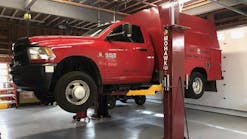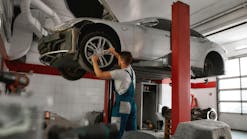Technology has made it so that vehicles need to return less often for oil changes and other services. This makes the courtesy inspection more important to the safety of the driver and the prevention of little issues becoming major failures. Consistent inspections are now more vital than ever in documenting vehicle conditions during these less frequent visits for the protection of not only the driver, but for your shop, too.
What do I mean by consistent inspections? Consistent inspections need to have the same approach on how the inspection is performed. Each vehicle must be checked using the same standards, the same methods. Documentation should always be similar. Each inspection, when looked at in chronological order, should show the exact progress of wear and tear on a vehicle over miles and time. When all these requirements are met, the future inspections should mostly show expected changes while uncovering few surprises.
The idea here is to build a continuity of inspections and service for each vehicle — just like a doctor does for a patient by checking their weight, temperature and blood pressure on each visit. The doctor does this to watch for changes in these vitals that may indicate a health issue in the early stages of manifestation, making it easier for them to address the malady before it gets worse.
Each subsequent inspection will uncover recommendations for work to be done either immediately or in the future. Keeping these items in the driver’s “car care consciousness” has several advantages.
1. It limits most of those “surprise” repairs or replacements because you and the customer will see them coming.
2. Done correctly, the inspection results can help the customer mentally prepare for the time when these things come due. Additionally, they can also financially prepare for the services.
3. Having this regular conversation about what is due and when, a level of trust will develop between driver and shop because you can show them over the various inspections what is happening with the vehicle, so they understand why the work is needed or suggested.
4. The customer will have to consistently return to your shop so that the changing conditions of the vehicle can be documented and compared. You have a much higher chance of selling to a returning customer.
The first step towards consistent inspections is putting an exact process in place that will be followed on every vehicle and every inspection, every time. It should not matter which tech will be performing each inspection will be performed the same. A system should be developed that approaches each vehicle the same way resulting in dependable measurements and checks.
Another advantage of putting a system in place is that the time to take each inspection should be about the same. Inspections that are done in less time should be subject to a recheck to be sure the process is being followed. A system can also lead to more predictability in how many inspections can be done in a day for maximum benefit.
When designing your inspection process consider the efficiency of how it will be done. For example, when the technician first gets into the vehicle, what items are immediately available for them to check? Key on engine off, instrument cluster and warning lamps. Key on engine running, engine noise and idle quality, place vehicle into gear check engagement and with the parking brake on to see if it holds the vehicle in place at idle. Check wipers and washer operation.
Driving around the parking lot checking brake and steering feel. Pulling into the bay blowing the horn and turning on the exterior lights for checking. The person in the next bay should take the horn being blown as their signal to help with the brake light checks when the vehicle is in the bay.
Taking this approach, you can build your inspection order based on what is available to inspect as the vehicle moves to being up on the lift with the oil being drained and inspection complete.
I should mention that making this process work, you will need to have the ability to build and or edit your inspections that you are using. If you are still currently using paper inspections, you will find your options limited by the inspection sheets you have access to unless you can create and print your own.
Having a digital inspection system in place that allows the editing and creation of inspections will give you the most flexibility as you both design and tweak your inspection process. I mention “tweaking” the inspections since over time you will note that the order of some of the points may not be the best. That’s the beauty of having the ability to modify your digital inspections, they can always and easily be changed if needed.
The next step in building your inspection process is setting the standards for how items are going to be checked and measured. Is the tire measurement the lowest one found, or will you have your techs measure three different spots on each tire and note the readings? Are all tires always going to be measured?
The same with brakes. Will the braking surfaces be always exposed for accurate measuring or will you allow visuals through the wheels when a rotation is not being performed? How will the measuring be done? What tools will be used to keep the readings consistent?
After deciding on the measuring methods there needs to be the conversation about what color swatch will be selected at what measurement. Deciding on the standards of what is considered green, yellow or red is one of the most important factors to be considered because the color swatch is the main method that the customer understands as the urgency of the needed repairs.
The driver of a vehicle has no idea of what 2/32 of an inch of brake material means to them. Or even 5 mm of tread left. But when they see red, they know it is something that needs to be dealt with sooner than later. Green is good or yellow is time to recommend the replacement.
So, your shop needs to have everyone on board of what measurements mean which color swatch is chosen so it is consistent across all inspections.
In Pennsylvania brakes under 2/32 of an inch will fail the Safety Inspection that needs to be performed once a year. Just the same, I would consider brakes at 3/32 to be the point that the red swatch would be chosen based on the fact that with the longer intervals between vehicle visits to the shop this will give a margin of wear before the brakes go metal to metal.
Other factors to take into consideration when setting your color swatch standards should include the area of the country your shop is located in. In urban areas there is more stop and go, so brake wear may be accelerated. Other areas where most driving being done is basically highway driving, will require a different approach.
Once the standards are set, everyone must be on board and in agreement with the specs adding to the consistency of the inspections.
Pictures are an integral part of digital inspections, so you also need to have standards for them too. These standards should include how many pictures and what they should show. The color swatch specification can be used as a determining factor for the number of pictures. Green swatch one picture. Yellow, minimum of two pictures. Red items get a minimum of three pictures. The most important aspect being that you have pictures for each level of wear. This will give you the wear history of the photographed items that you will use to prepare your customer for needed work and building a complete level of trust with them.
The advisors need to be on board with the sharing and using the inspection with the customers. The advisors need to present and or send the inspections to each costumer. Go over the details and findings of each one. Compare today’s inspection findings to the last visit. Instill in the customer that this these inspections will help them take better care of their vehicles with a better chance of not being hit with large surprise repairs.
It must be communicated to and understood by the customer that for this process to work, they need to return to your shop for each service so that the inspections can track the wear and tear on their vehicle. Going to other shops will leave gaps in the vehicle’s history.
This helps your shop in keeping more customers. Returning customers are more apt to purchase from your shop than those that are in for first visits. Matter of fact they are 65% more likely to have you do the work needed on their vehicles because you are developing a trust with them by using these inspections as a guide to their vehicle’s service needs.
Another advantage to having quality, consistent inspections is covering your shop against some of the possible issues that come up in automotive repair. Documentation will almost always keep you out of trouble. If your documentation is the result of processes and procedures that are followed every day on every inspection. Your chances of having issues in a court case are greatly reduced.
Seems like a lot to do. And at first it will be. When you build your canned jobs, you need to spend a fair amount of time up front creating them. But every time you use the same ones over and over, they are paying you back on that initial investment of time.
Having procedures in place that give your inspections consistency. Processes and specifications in place. Building vehicle histories for each vehicle that indicates what is needed in the future will keep your customers coming back through trust and education. Customers that are consistently happy with your shop, will have your shop be consistently successful. Isn’t that what it is all about?


